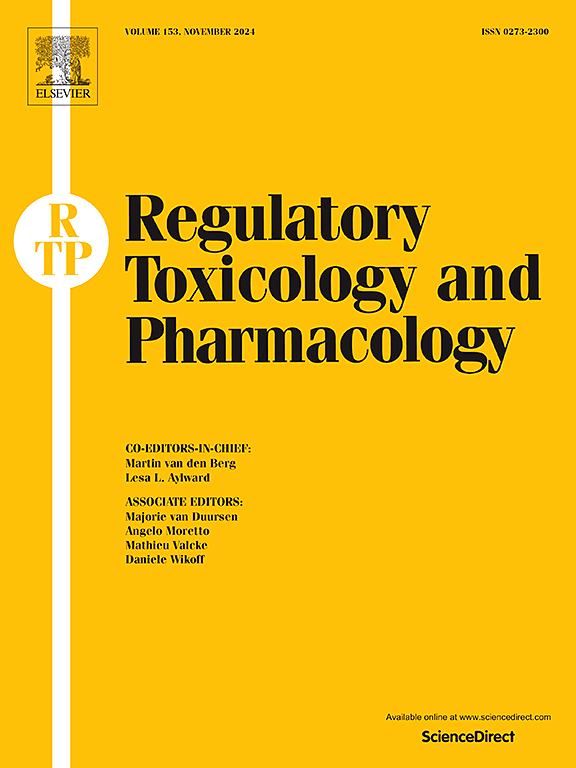Interpretable machine learning unveils key predictors and default values in an expanded database of human in vitro dermal absorption studies with pesticides
IF 3
4区 医学
Q1 MEDICINE, LEGAL
引用次数: 0
Abstract
The skin is the main route of exposure to plant protection products for operators, workers, residents, and bystanders. Assessing dermal absorption is key for evaluating pesticide exposure. The initial approach to risk assessment involves using default dermal absorption values or applying read-across data from experimental results from different formulations. In this way, to support non-dietary pesticide risk assessment focused but not limited to Brazil, this project evaluated 759 GLP-compliant in vitro human skin dermal absorption studies covering 25 formulation types and 248 active substances at multiple concentrations using interpretable machine learning techniques. Bayesian Additive Regression Trees – BART method indicated that Log Pow and molecular weight have the highest importance when predicting dermal absorption; both parameters exhibit moderate interaction uncertainty within each other and with formulation groups water-based and organic-solvent based and with tested form (concentrates or dilutions). The default values for each formulation group were determined using the upper bound of a non-parametric confidence interval for a specified quantile, with calculations conducted via bootstrapping methods; the proposed values correspond to the upper limit of the 95% confidence interval for the 95th percentile: for concentrates, 10% for organic-solvent based, 4% for water-based and 3% for solid formulations. For dilutions, 42% for organic-solvent based, 37% for water-based and 39% for solid formulations. Organic-solvent based dermal absorption values from experimental data can be used as conservative surrogates for solid and water-based formulations. When no experimental data is available for higher spray dilutions of a given formulation type, a pro-rated correction is proposed to a 2 to 5-fold concentration difference, limited to the respective formulation group default value.
可解释的机器学习揭示了农药人体体外皮肤吸收研究扩展数据库中的关键预测因子和默认值。
皮肤是操作人员、工人、居民和旁观者接触植保产品的主要途径。评估皮肤吸收是评估农药暴露的关键。风险评估的初始方法包括使用默认的皮肤吸收值或应用来自不同配方的实验结果的读取数据。通过这种方式,为了支持以但不限于巴西为重点的非膳食农药风险评估,该项目使用可解释的机器学习技术评估了759项符合glp标准的体外人体皮肤吸收研究,涵盖25种剂型和248种不同浓度的活性物质。贝叶斯加性回归树- BART方法表明,Log Pow和分子量在预测皮肤吸收时最重要;这两个参数在彼此之间、与配方组之间、与水基和有机溶剂基之间以及与测试形式(浓缩或稀释)之间都表现出适度的相互作用不确定度。每个配方组的默认值使用指定分位数的非参数置信区间的上界来确定,并通过自举方法进行计算;建议的值对应于第95百分位95%置信区间的上限:对于浓缩物,有机溶剂基为10%,水基为4%,固体配方为3%。对于稀释剂,有机溶剂为42%,水基为37%,固体配方为39%。基于实验数据的有机溶剂的皮肤吸收值可以作为固体和水基配方的保守替代品。当没有实验数据可用于给定配方类型的较高喷雾稀释度时,建议按比例校正浓度差2至5倍,仅限于各自配方组的默认值。
本文章由计算机程序翻译,如有差异,请以英文原文为准。
求助全文
约1分钟内获得全文
求助全文
来源期刊
CiteScore
6.70
自引率
8.80%
发文量
147
审稿时长
58 days
期刊介绍:
Regulatory Toxicology and Pharmacology publishes peer reviewed articles that involve the generation, evaluation, and interpretation of experimental animal and human data that are of direct importance and relevance for regulatory authorities with respect to toxicological and pharmacological regulations in society. All peer-reviewed articles that are published should be devoted to improve the protection of human health and environment. Reviews and discussions are welcomed that address legal and/or regulatory decisions with respect to risk assessment and management of toxicological and pharmacological compounds on a scientific basis. It addresses an international readership of scientists, risk assessors and managers, and other professionals active in the field of human and environmental health.
Types of peer-reviewed articles published:
-Original research articles of relevance for regulatory aspects covering aspects including, but not limited to:
1.Factors influencing human sensitivity
2.Exposure science related to risk assessment
3.Alternative toxicological test methods
4.Frameworks for evaluation and integration of data in regulatory evaluations
5.Harmonization across regulatory agencies
6.Read-across methods and evaluations
-Contemporary Reviews on policy related Research issues
-Letters to the Editor
-Guest Editorials (by Invitation)

 求助内容:
求助内容: 应助结果提醒方式:
应助结果提醒方式:


